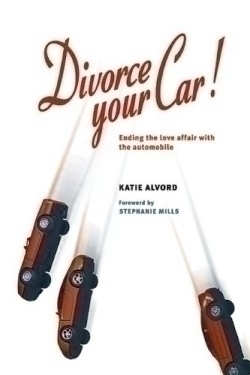It looks like you've stumbled upon a page meant to be read by our code instead of viewed directly. You're probably looking for this page.
Divorce Your Car!
Ending the Love Affair with the Automobile
Cars are nearly irresistible. They offer unparalleled mobility as they can reach most destinations quickly and at the convenience of the driver, who expends minimal physical effort (at least for the driving). This “freedom,” however, comes with tremendous cost, both to the car owner and society. Alvord is not the first author to catalog the costs associated with the automobile.
Most readers already know the story: automobile transportation is the second largest expenditure for most North American households, the major source of air pollution and global warming, the number one killer of children in the U.S. and the agent of habitat-destroying suburban sprawl. What Alvord—a long-time transportation reform advocate and freelance writer—offers, for those who are troubled by these characteristics, is a way out of car dependency.
“To those still tightly entangled in the auto-driver relationship, divorcing a car might seem the height of impossibility, or even foolhardiness,” Alvord writes. “But venture into the territory of those who’ve done it and you’ll find that divorce from a car is not only possible, it can bring unexpected delights and great rewards.”
Alvord lays out various strategies, weaving into her narrative the personal experiences of dozens of individuals and families throughout the U.S. and Canada who walk, bike, take transit, carpool, car share or telecommute. These are people who have found that “on a personal level, [car divorce] can be incredibly liberating, bringing less stress, more money, better health and fitness, reduced risk of accidental death, and a simpler lifestyle,” Alvord writes.
At its most basic level, a car divorce requires merely a change in attitude: a commitment to drive less. For some, this may mean planning errands to maximize the most efficient use of the car; others may find their families can get by without a second car. More than a few pioneers may try total car-free living. For those who want to go beyond personal lifestyle changes, Alvord offers advice on advocating for policy changes that benefit non-drivers.
Ironically, Alvord lives in Michigan, only hundreds of miles from the world car capital, Detroit. Her own experience with car divorce living eleven miles from the nearest town in a region that is not served by public transportation and receives anywhere from 100 to 400 inches of snow each winter lends a credibility to her work that should resonate with readers facing much less difficult circumstances.
One of the beauties of this book is that it doesn’t come from a policy “think-tank” or university, although its author does a remarkable job of extracting the essentials from the myriad transportation studies produced by such organizations in the past three decades. This book is painstakingly researched and thoroughly documented, but the materials are presented in a lively and readable manner, accompanied by terrific cartoons and margin quotes.
Alvord also provides what is perhaps the most complete bibliography and selection of resources available anywhere for those interested in alternative transportation and land-use issues. It all goes to make this book a major resource for those envisioning a twenty-first century without the destructive addiction of the past century as well as a very persuasive argument for doing so.
Reviewed by
Sharon Flesher
Disclosure: This article is not an endorsement, but a review. The publisher of this book provided free copies of the book to have their book reviewed by a professional reviewer. No fee was paid by the publisher for this review. Foreword Reviews only recommends books that we love. Foreword Magazine, Inc. is disclosing this in accordance with the Federal Trade Commission’s 16 CFR, Part 255.
